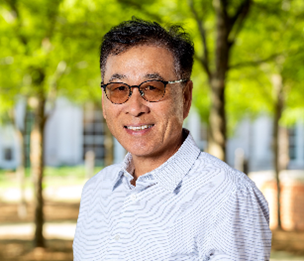News Story
Celebrating Asian, Pacific Islander, and Desi American Engineers

The University of Maryland (UMD) recognizes Asian, Pacific Islander, Desi American (APIDA) Heritage Month in April instead of May, ensuring a full month of celebration before campus begins summer break. Visit the Adele H. Stamp Student Union Center for Campus Life’s full calendar of campus-wide events.
The A. James Clark School of Engineering is proud to join in the month-long affirmation of the experiences and contributions of APIDA communities. The impact made by APIDA engineers—at the Clark School, and on our country and world—improves our community and field in numerous and significant ways. A multitude of backgrounds, perspectives, and expertise contribute to better engineering solutions designed to serve users, therefore benefitting more of society. We are honored to share stories from the following Maryland engineers who have made an indelible impact on the UMD campus, the engineering discipline, and our shared future.
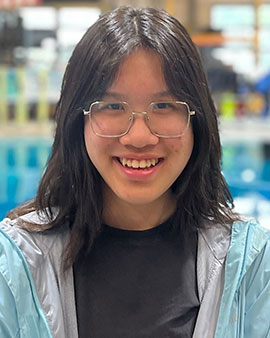 The daughter of Chinese and Japanese immigrants, aerospace engineering sophomore Akemi Takeuchi’s gateway to engineering was origami—both an important cultural touchpoint and introduction to the art of design. With a love for building and a knack for math, by fifth grade Takeuchi decided she wanted to be an engineer. Three years later, she took part in a UMD summer program hosted by the Women in Engineering Program. “I remember touring the labs, like the Neutral Buoyancy Research Facility,” she said. “Now I work next door to it all the time.”
The daughter of Chinese and Japanese immigrants, aerospace engineering sophomore Akemi Takeuchi’s gateway to engineering was origami—both an important cultural touchpoint and introduction to the art of design. With a love for building and a knack for math, by fifth grade Takeuchi decided she wanted to be an engineer. Three years later, she took part in a UMD summer program hosted by the Women in Engineering Program. “I remember touring the labs, like the Neutral Buoyancy Research Facility,” she said. “Now I work next door to it all the time.”
In addition to her studies, Takeuchi works with the Balloon Payload Program and led much of the planning for UMD Nearspace, the university's part in NASA’s Nationwide Eclipse Ballooning Project. For balloon launches, her team works on a venting apparatus that allows the balloon to achieve neutral buoyancy, or float, at 80,000 feet above the earth’s surface, an “exhilarating” experience, she said.
Takeuchi says she’s been pushed out of her comfort zone at UMD—a good thing. Initially “terrified” of mentoring, she worked as a mentor for ENAE100: The Aerospace Engineering Profession, loved it, and now plans to prioritize mentoring over the next couple years. Excited for what comes next, this summer the planetary sciences minor will intern at NASA, where she’ll study Jupiter’s moon Europa. She says her own mentors, especially senior aerospace engineering major Kruti Bhingradiya, helped her develop confidence in herself, Takeuchi said. “Being able to relate, and share our stories and experiences, makes me want to uplift others.”
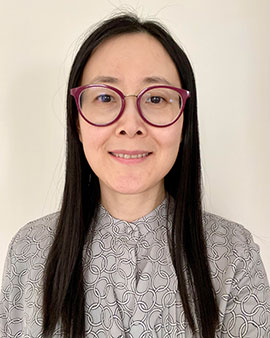 For Lan Ma, engineering seemed like a natural fit. Her mother and father are both retired professors of engineering in China; Ma grew up reading famous popular science books by Chinese author Ye Yonglie—among them, “One Hundred Stories of Scientists” and “One Hundred Thousand Whys”—gifts from her parents. “It was through osmosis that I followed in their path to study engineering,” she said.
For Lan Ma, engineering seemed like a natural fit. Her mother and father are both retired professors of engineering in China; Ma grew up reading famous popular science books by Chinese author Ye Yonglie—among them, “One Hundred Stories of Scientists” and “One Hundred Thousand Whys”—gifts from her parents. “It was through osmosis that I followed in their path to study engineering,” she said.
Today Ma serves the Fischell Department of Bioengineering as a faculty lecturer and assistant director of the Biocomputational Engineering (BCE) program—an undergraduate degree that debuted in 2021. One of the first programs of its kind in the U.S., BCE is set to become the nation’s first ABET-accredited undergraduate program of its kind. Ma’s mission? To make growth in the relatively new field sustainable in the U.S. through excellent undergraduate education. Training the next generation of biocomputational engineers comes with inherent difficulties: “It’s a highly interdisciplinary field. You have to comprehend engineering along with various disciplines in the physical and biological sciences, as well as computation and data science,” Ma explained. “It’s very challenging for students—and for teachers and researchers, too.”
In the long-term, biocomputational engineering, including image analysis and mathematical modeling, can shed light on fundamental questions related to drug design and disease mechanisms to ultimately engineer better medicine. In the near-term, Ma is looking forward to the Clark School’s first annual Capstone Design Expo, where her students will present their capstone research: coronavirus morphology analysis using artificial intelligence (AI). “It’s an opportunity for BCE seniors to integrate all the skills they’ve learned in a year and a half to solve a real-world biomedical problem,” she said.
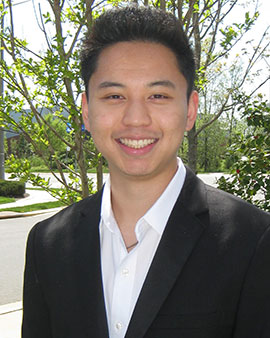 Senior civil and environmental engineering major Justin Wu grew up around his father’s building supplies and tools. An expert in everything from carpentry to plumbing, the small business owner inspired his son to carry on the family tradition of building things better. Born and raised in Germantown, Maryland, Wu set his sights on the Clark School. “My parents are both from China and didn’t go to college,” he said, “so being a first-generation college student is a very big thing in my family.”
Senior civil and environmental engineering major Justin Wu grew up around his father’s building supplies and tools. An expert in everything from carpentry to plumbing, the small business owner inspired his son to carry on the family tradition of building things better. Born and raised in Germantown, Maryland, Wu set his sights on the Clark School. “My parents are both from China and didn’t go to college,” he said, “so being a first-generation college student is a very big thing in my family.”
He’s proudest of making it through his first- and second-year engineering courses so he could focus on the project management courses he plans to apply to his career. Wu’s project management specialization is traffic—an everyday problem in the Baltimore-Washington corridor. In the Traffic Safety and Operations Lab, he’s working on one potential solution: an automated flagger assistance device to control traffic remotely and safely. Wu says the Clark School does a great job of connecting students with real-world opportunities: he’s interned at civil engineering firm Clark Azar & Associates, inspection agency Engineering Consulting Services, Jacobs Solutions, and JMT, where he’ll work as a traffic design engineer after graduation.
Wu has also been involved with the UMD chapters of the American Society of Civil Engineers and Engineers Without Borders, as well as playing intramural basketball, volleyball, and dodgeball. He likes the variety of activities and to get to know his peers socially. “It helps to connect with the people I’m working with in classes and the lab, to know them on a personal level,” he said.
 For Vince Nguyen ’03, Ph.D. ’11, a proud alumnus and mechanical engineering senior lecturer, service to community is job one. Over his five years in his current role, Nguyen has initiated and cultivated many initiatives for the Clark School and local communities, earning him the 2022 Faculty Service Award. His biggest accomplishment to date? The GOAL (Get Out and Learn) Engineering Kit program, created in partnership with the Women in Engineering Program, serves some 2,400 local school system students annually, advancing STEM education in a fun and exciting way. “Being from the neighborhoods, I have personal and professional connections to Prince George’s County,” Nguyen said. “Finding ways for my work to impact people right here in Maryland’s backyard is very important to me.”
For Vince Nguyen ’03, Ph.D. ’11, a proud alumnus and mechanical engineering senior lecturer, service to community is job one. Over his five years in his current role, Nguyen has initiated and cultivated many initiatives for the Clark School and local communities, earning him the 2022 Faculty Service Award. His biggest accomplishment to date? The GOAL (Get Out and Learn) Engineering Kit program, created in partnership with the Women in Engineering Program, serves some 2,400 local school system students annually, advancing STEM education in a fun and exciting way. “Being from the neighborhoods, I have personal and professional connections to Prince George’s County,” Nguyen said. “Finding ways for my work to impact people right here in Maryland’s backyard is very important to me.”
As one of the faculty leads for the Environmentally and Socially Responsible Engineering (ESRE) program, part of UMD’s implementation of the Engineering for One Planet initiative, Nguyen thinks globally while acting locally. The ESRE team is working to introduce meaningful aspects of environmental, economic, and societal sustainability into all required courses within engineering. To do this, the group is developing a teaching certificate program with UMD’s Teaching and Learning Transformation Center and plans to roll out the certificate program first to Clark School faculty and then faculty across the university.
Nguyen credits his parents who came to the U.S. fleeing the Vietnam War for his strong work ethic, resilience, and community mindset. “As a family, we recognized we received a lot of help. Understanding how much the community around us enabled us to succeed is something that’s always there,” he said. “Trying to positively impact my communities is how I give back.”
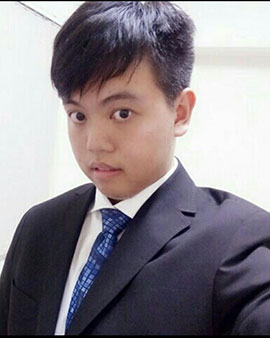 Ren-jhe Chung was attracted to UMD and the Clark School for the community and large number of international students. Still, the graduate student from Taiwan experienced culture shock his first semester in the U.S.: American students ask a lot of questions, he said, something Taiwanese students don’t do. Then there was the language barrier, which made things “tough.” Chung credits Associate Professor Amy J. Karlsson in the Department of Chemical and Biomolecular Engineering for taking the time to help him find his footing. Three years later, he has hit his stride—academically and socially.
Ren-jhe Chung was attracted to UMD and the Clark School for the community and large number of international students. Still, the graduate student from Taiwan experienced culture shock his first semester in the U.S.: American students ask a lot of questions, he said, something Taiwanese students don’t do. Then there was the language barrier, which made things “tough.” Chung credits Associate Professor Amy J. Karlsson in the Department of Chemical and Biomolecular Engineering for taking the time to help him find his footing. Three years later, he has hit his stride—academically and socially.
Working in the Karlsson Lab, Chung researches at the intersection of biology and engineering, using protein engineering strategies to improve the understanding of human diseases. He’s currently focused on the problem of the naturally occurring pathogen Candida albicans, a multidrug-resistant fungus that can cause infection. The (potential) solution? A small protein that could kill the stubborn pathogen. “My work is focused on producing and purifying this protein, which takes lots of time,” he said. “The next step is to see if we need to make modifications, or if it really works.”
Drawn to solving the Grand Challenge of engineering better medicines, Chung has high hopes. He’s in good company—these days, he feels most at home around his lab mates. He also appreciates the work of the Chemical and Biomolecular Engineering Graduate Student Association. “They are good about helping students engage—not for any academic purpose but just to help us get to know each other socially.”
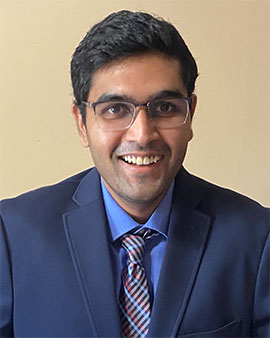 Sahil Shah, assistant professor of electrical and computer engineering, joined the Clark School in 2021, motivated to work with students and discover the interdisciplinary possibilities for his research—which are “really needed for building systems today,” he said.
Sahil Shah, assistant professor of electrical and computer engineering, joined the Clark School in 2021, motivated to work with students and discover the interdisciplinary possibilities for his research—which are “really needed for building systems today,” he said.
In the past few years, his work building and applying integrated circuits and semiconductor devices has only increased in national importance. (The Creating Helpful Incentives to Produce Semiconductors and Science Act of 2022, or CHIPS Act, was passed into law in 2022.) With these devices, Shah’s lab investigates and designs low-power systems that can compute efficiently in a low-resource environment, such as implantable or wearable platforms. Among the Grand Challenges of Engineering he is drawn to solving, Shah is focused on energy efficiency: “For instance, using less energy for computing AI workloads—such as algorithms that power ChatGPT—can have a real impact on climate change,” he said.
An affiliate fellow of the Robert E. Fischell Institute for Biomedical Devices, Shah’s rehabilitation engineering research earned him a National Science Foundation (NSF) CAREER Award earlier this year. His project involves developing robust brain-machine interfaces for enabling individuals with neurological conditions and sensory or motor impairments to control prosthetic devices or computers. Alongside the technical goals, the project includes an educational component. “I’m excited about the research and to be able to mentor students as part of it,” he said. “I’m excited to collaborate with community colleges and high schools to encourage a new generation of students in STEM.”
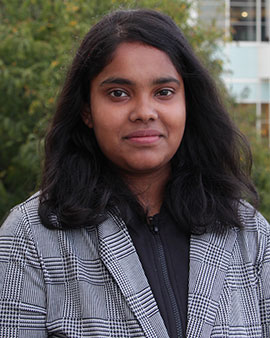 Since studying the galaxies in fifth grade science class, Pikesville, Maryland-native Joynob “Joy” Kaoshar has been “mesmerized” by space. While she acknowledges that career expectations are slowly changing in her Southeast Asian culture, she says engineering is still often seen as a field for men; women are often instead encouraged to go into the medical field. She knew her career decision was important, and not only for herself. “I wanted to be a role model for the girls in my family,” said the board member of Women in Aeronautics and Astronautics at UMD. “You can be whatever you want to be.”
Since studying the galaxies in fifth grade science class, Pikesville, Maryland-native Joynob “Joy” Kaoshar has been “mesmerized” by space. While she acknowledges that career expectations are slowly changing in her Southeast Asian culture, she says engineering is still often seen as a field for men; women are often instead encouraged to go into the medical field. She knew her career decision was important, and not only for herself. “I wanted to be a role model for the girls in my family,” said the board member of Women in Aeronautics and Astronautics at UMD. “You can be whatever you want to be.”
At the Clark School, the senior aerospace engineering major is on the space track, and has seized many opportunities to propel her along her chosen path. Kaoshar is a member of the first group at the Clark School to pursue a hypersonic aircraft design for a capstone project, and she interned in the U.S. Air Force’s Hypervelocity Wind Tunnel 9. She has been involved with the UMD Terrapin Rocket Team, where she serves as the first officer for diversity, equity, and inclusion. She also helped design the autonomous “BOB,” short for buoyancy-operated bot at the Maryland Robotics Center. “The idea,” Kaoshar said, “would be to deploy fleets of BOBs to explore oceanic ecosystems without needing a large research vessel or even a diver to do it.”
With plans to work in the defense industry after graduation, the soon-to-be graduate lists mentorship among her most formative Clark School experiences. Kaoshar has been very involved with the Sheila Rohra WIE (Women in Engineering) Connect Peer Mentoring Program, growing through the years from a mentee to mentor to mentor coordinator. She counts communication, program management, and event planning among the skills she learned. “I grew as a leader and gained a lot of confidence,” she said.
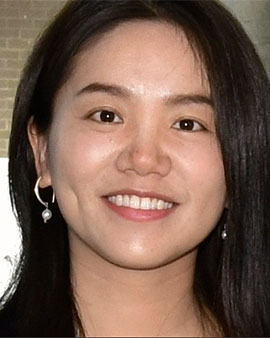 In her 18 months at the Clark School, Shuna Ni, assistant professor in the Department of Fire Protection Engineering (FPE), has been very busy. In 2022, her research team was awarded more than $500,000 from the National Institute of Justice to study the impact of architectural finishes on fire patterns and to develop data-driven tools for fire pattern analysis. In 2023, she led a team awarded $197,000 from the NSF to study structure losses in the Maui wildfires. She was also awarded a 2023 Grand Challenges Grant from UMD; Ni’s team aims to understand the impact of wind on the fire dynamics in mass-timber (manufactured wood) construction. All of these projects address the Grand Challenges for Engineering: “We want to mitigate the impacts of climate change for a more sustainable society,” said Ni.
In her 18 months at the Clark School, Shuna Ni, assistant professor in the Department of Fire Protection Engineering (FPE), has been very busy. In 2022, her research team was awarded more than $500,000 from the National Institute of Justice to study the impact of architectural finishes on fire patterns and to develop data-driven tools for fire pattern analysis. In 2023, she led a team awarded $197,000 from the NSF to study structure losses in the Maui wildfires. She was also awarded a 2023 Grand Challenges Grant from UMD; Ni’s team aims to understand the impact of wind on the fire dynamics in mass-timber (manufactured wood) construction. All of these projects address the Grand Challenges for Engineering: “We want to mitigate the impacts of climate change for a more sustainable society,” said Ni.
With a civil engineering background, Ni was drawn to the Clark School for its interdisciplinary strengths and its standout reputation for fire research. She credits her colleagues, in particular Professor Emeritus (and immediate past FPE chair) James Milke ’76, M.S. ’81, Ph.D. ’91 for helping her round out her skills as a professor. As the first woman faculty member in FPE, Ni takes student engagement very personally. “I think I have a responsibility to talk to women undergraduates, tell them how much I enjoy this research, and encourage them to consider joining this program,” she said.
Having come to the U.S. for her Ph.D. in 2012, Ni said life as an international student could be isolating at times. Here at the Clark School, however, she feels “a strong sense of belonging,” she said. “There are people from many different backgrounds, working for the same goal—a better society.”
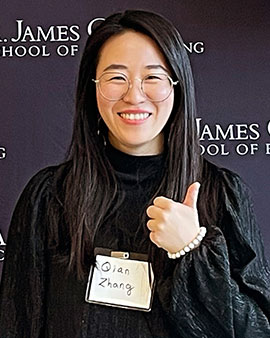 For postdoctoral researcher Qian Zhang Ph.D. ’22, her academic career has followed a multidisciplinary trajectory. Working on her doctorate in chemistry at UMD, she studied plasmonic nanomaterials. From fundamental study to more practical applications, Zhang now works in the lab of Distinguished Professor Liangbing “Bing” Hu, the director of the Center for Materials Innovation. She’s grateful for her chemistry background: “We need to know the science behind the engineering problems,” she said. “Now I’m ready to solve them in the real world.”
For postdoctoral researcher Qian Zhang Ph.D. ’22, her academic career has followed a multidisciplinary trajectory. Working on her doctorate in chemistry at UMD, she studied plasmonic nanomaterials. From fundamental study to more practical applications, Zhang now works in the lab of Distinguished Professor Liangbing “Bing” Hu, the director of the Center for Materials Innovation. She’s grateful for her chemistry background: “We need to know the science behind the engineering problems,” she said. “Now I’m ready to solve them in the real world.”
The projects Zhang is working on in the lab include a new insulation paper for power transformers; by making the cellulose-based paper with additives to elevate both mechanical strength and thermal conductivity, the paper can extend a transformer’s lifespan. Another ongoing study: generating a plasma technology capable of reaching 8,000 Celsius (hotter than the surface of the sun). A simple and practical plasma technology, the invention may help enable large-scale electrified plasma manufacturing.
This year, Zhang is celebrating 10 years since coming to the U.S. from China. She’s glad to have spent much of that time at UMD, where she’s made friends and colleagues across several departments. For her current work in the lab, she makes good use of the Maryland NanoCenter and Terrapin Works, resources that enable her to push projects forward easily. “The university provides a very rich environment for people to study here,” she said. She added with pride, “I’m a Terp.”
 Junior aerospace engineering major and Clark Ambassador Ankit Verghese’s first dream job was to be a pilot. So he feels like he’s come “full circle,” he said, studying flight at the Clark School. Drawn to Maryland Engineering for its hands-on research opportunities, in addition to his studies Verghese is chief engineer of Terraformers, a competitive team under Robotics at Maryland dedicated to building a full-scale, autonomous Mars rover and drone. He has also interned at NASA, and has published a paper on research into pressure-based Vertical Takeoff and Landing (VTOL).
Junior aerospace engineering major and Clark Ambassador Ankit Verghese’s first dream job was to be a pilot. So he feels like he’s come “full circle,” he said, studying flight at the Clark School. Drawn to Maryland Engineering for its hands-on research opportunities, in addition to his studies Verghese is chief engineer of Terraformers, a competitive team under Robotics at Maryland dedicated to building a full-scale, autonomous Mars rover and drone. He has also interned at NASA, and has published a paper on research into pressure-based Vertical Takeoff and Landing (VTOL).
Named “AVTOL”—a combination of his initials and VTOL—Verghese designed the proof-of-concept aircraft with computer-aided design and computational fluid dynamics software, as well as machine learning. With an interest in solving the Grand Challenges for Engineering related to transportation and the environment, he notes the benefits of vertical flight, including a reduction in the urban sprawl and resulting deforestation that come with today’s airports.
This summer, the New Jersey native will intern at Collins Aerospace. After graduation? He’s “not 100 percent sure,” he said. Whether in graduate school or industry, Verghese wants to work on drones or “cool airplanes.” He says his family and background help keep him motivated to achieve his goals. He draws inspiration from his older cousins and his brother, who is in medical school. His background plays a part, too. “Being Indian, it’s part of the culture to be the best we can be in whatever we do,” Verghese said.
 Department of Chemical and Biomolecular Engineering Professor Kyu Yong Choi traces his origins as an engineer to a significant partnership between the U.S. and his native South Korea. A middle school student at the time, Choi remembers the 1966 announcement of the founding of the Korea Institute of Science and Technology (KIST), and specifically being introduced through the media to the terms “research” and “research institute.” From that point, he dreamed of being a scientist or an engineer. After receiving his bachelor’s and master’s degrees in chemical engineering from Seoul National University, he came to the U.S. to pursue his Ph.D. “That’s where the dream unfolded,” he said.
Department of Chemical and Biomolecular Engineering Professor Kyu Yong Choi traces his origins as an engineer to a significant partnership between the U.S. and his native South Korea. A middle school student at the time, Choi remembers the 1966 announcement of the founding of the Korea Institute of Science and Technology (KIST), and specifically being introduced through the media to the terms “research” and “research institute.” From that point, he dreamed of being a scientist or an engineer. After receiving his bachelor’s and master’s degrees in chemical engineering from Seoul National University, he came to the U.S. to pursue his Ph.D. “That’s where the dream unfolded,” he said.
Over his 40 years at UMD, Choi’s prediction that the university would become a top research university has come true. Two decades after KIST’s founding and two years into his time at the Clark School, in 1986 Choi received the prestigious Presidential Young Investigator Award from the NSF. That same year, he became one of the founding faculty members of the Systems Research Center (now the Institute for Systems Research), the first center of its kind to be supported by the NSF. “Interdisciplinary research was a new idea then,” he said. “The center contributed a lot to successful collaboration across departments—and to the development of my career.”
Today, Choi leads the Polymer Reaction Engineering Laboratory. His work in industry includes recent collaborations with ExxonMobil, for which he contributed to the foundation of the model for the multinational corporation’s first polyethylene plant based on metallocene catalyst technology, a “very satisfying” accomplishment, he said. “Instead of just writing papers of interest to academic researchers, I believe as engineers we have the responsibility to contribute to the advancement of industrial technology.”
Published April 19, 2024




